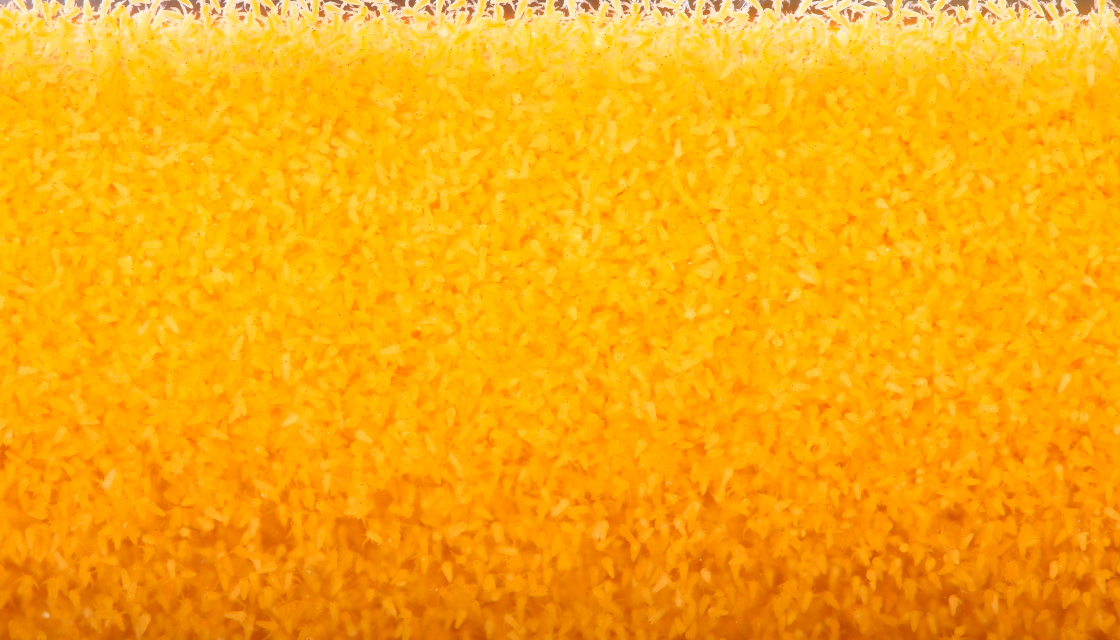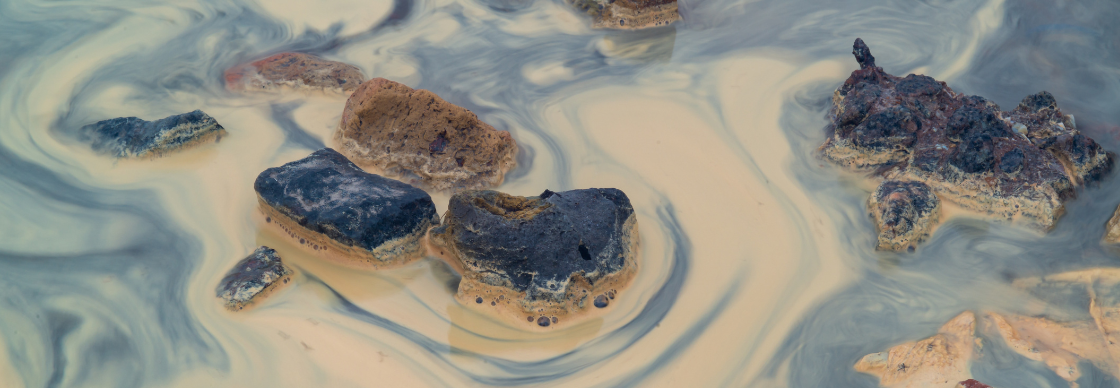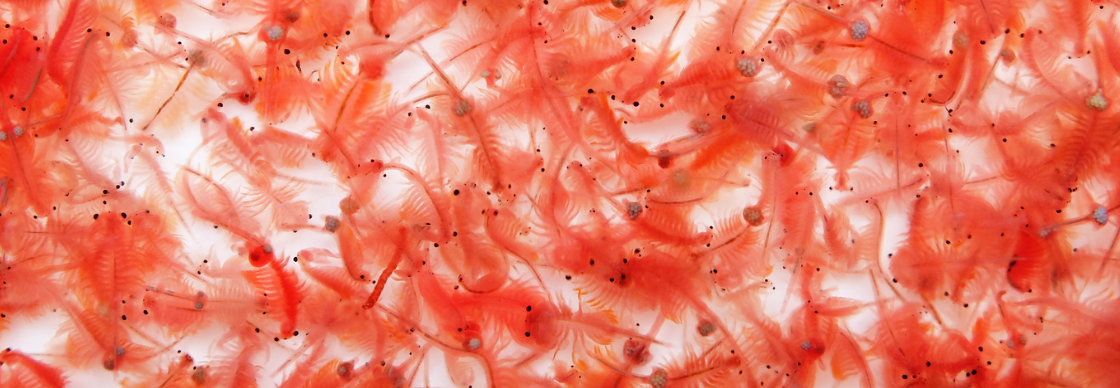Artemia – History, Applications, and Future as Fish Food. A Review of Research

Providing the right food at the correct stage of life is crucial to the health, fitness, and proper development of aquarium fish and can determine the success or failure of breeding efforts. Artemia is one of those fish diet components worth exploring further, given its long history and enduring popularity in aquaristics. Although small, its impact on the health and growth of fish can be disproportionately large. In this article, we look into what has made these unassuming organisms one of the most frequently chosen foods in aquaristics and which aquarium fish species benefit from including Artemia in their diet.
What is Artemia?
Let’s start with the basics: what exactly is Artemia? Simply put, it is a tiny shrimp with a segmented body and delicate limbs used for swimming and gathering food. Despite its small size—an adult male measures only 8–10 mm in length, and a female about 10–12 mm—Artemia holds immense potential.
The Artemia genus includes many species with varying reproductive strategies. Some species reproduce sexually, while others reproduce through parthenogenesis, allowing females to produce offspring without males. This classification can be challenging, especially since the term "salina" is commonly used as a general term for different species, even though technically it refers to a specific type of Artemia found in the Mediterranean region.
Artemia is an incredibly resilient organism that, through evolution, has adapted to live in environments with extremely high salinity, such as salt lakes and coastal saline waters. Artemia’s ability to withstand extreme conditions has made it invaluable in aquaculture. When conditions drastically worsen, Artemia enters a state of diapause—forming cysts that can survive extreme temperatures, droughts, and low oxygen levels. Combined with its ability to resume life when conditions improve, Artemia has proven to be an irreplaceable source of natural food in aquarium fish breeding.
Where does the Artemia we feed our fish come from?
As mentioned, Artemia is an organism capable of surviving in highly saline environments, such as salt lakes, coastal salines, and man-made salt ponds. Its natural habitats can be found worldwide, from the Great Salt Lake in the USA to water bodies in Russia, Kazakhstan, and the Mekong Delta in Vietnam. Due to its high tolerance for salinity—Artemia can survive in waters with a salinity ranging from 10 to 340 g/l—these tiny shrimp have managed to colonize places where other organisms cannot survive. But presence alone isn’t enough; population growth also depends on optimal conditions like the right temperature and salt concentration.
Despite their wide availability, harvesting Artemia cysts from the wild presents significant ecological challenges. The Great Salt Lake in Utah remains a primary source of Artemia for global aquaculture, but over-harvesting, combined with the effects of climate change (fluctuating water levels and salinity), can negatively impact the balance of the lake's unique ecosystem. Excessive Artemia harvesting, especially with rising global demand, raises legitimate concerns about resource sustainability.
To reduce pressure on the Great Salt Lake, efforts have been made to diversify Artemia sources to other salt lakes in Russia, Kazakhstan, and China. The Mekong Delta region in Vietnam has become an example of a sustainable local production model—cysts are collected in a controlled manner and regularly monitored by local authorities.
Another innovative response to growing demand is Artemia farming in controlled environments. Advances in harvesting and processing cysts also play a significant role in minimizing environmental impact. For example, devices like the SEP-Art separator enable easier separation of cysts from nauplii without using harmful chemicals. Companies producing Artemia have also introduced probiotics to support a healthy bacterial flora in cultures, reducing the need for antibiotics.

What makes Artemia so popular as fish food?
Artemia has a rich history as a staple food in aquaculture and has remained essential in aquarium fish breeding for decades. Its popularity began as early as the 1930s when it was discovered that Artemia is an excellent food source for the larvae of numerous fish species, not only due to its size but also because of its nutritional value. The greatest advantage of Artemia, however, lies in its availability, ease of use, and versatile applications. Artemia cysts, which are dormant eggs, are a readily accessible and convenient source of fish food—just store them under suitable conditions, and they’ll be ready for use at any time.
Despite its benefits, Artemia is not without its limitations—it may lack certain key nutrients, especially omega-3 fatty acids such as DHA and EPA, which are crucial for the healthy growth of marine fish. In aquaculture, alternative organisms like rotifers and copepods are increasingly used as they naturally inhabit oceanic environments and are rich in essential fatty acids. However, these species are more challenging to cultivate, making Artemia an important player in the fish food market due to its availability and continued capacity to meet the ever-growing demand of the aquarium industry.
Enriched Artemia - What is it and Why?
With technological advances and an increasing understanding of fish nutrition, new food sources and methods for enhancing them are continually sought. One such innovation is enriched Artemia. This refers to the classic Artemia, but fortified with additional nutrients that are lacking in its basic form.
The idea behind enriching Artemia addresses the deficiency of essential nutrients, particularly omega-3 fatty acids such as EPA, DHA, and arachidonic acid (ARA), which are crucial for the proper growth and immunity of marine fish larvae. These fatty acids support the development of the nervous and immune systems as well as skin health in fish, and their absence can lead to lower larval survival rates and poorer quality fish.
Various enrichment techniques enable a more balanced food supply for fish, rich not only in proteins and fats but also in phospholipids, vitamins, antioxidants, and trace elements. This supports fish at the cellular level—healthy cell membranes enhance their natural color, resulting in vibrant hues, and strengthen their resistance to infections and diseases.
There are numerous ways to enrich Artemia, from easy-to-use commercial products to more advanced methods. One approach involves feeding Artemia with omega-3-rich microalgae, yeast, or bacteria, which provide valuable lipids and amino acids. Some breeders also use fish oils, like cod liver oil, to increase the fatty acid content of the final product.
Enriched Artemia offers many benefits, particularly for marine fish that naturally require higher amounts of omega-3 fatty acids. Fish fed with enriched Artemia not only grow faster but are also more resistant to stress and disease. Thanks to higher levels of antioxidants, vitamins, and fatty acids, these fish also have brighter colors, contributing to a healthy and appealing appearance.
For many breeders, enriching Artemia has become a standard practice rather than just an option. The goal is to provide fish with a complete diet that supports their development at all life stages. Modern enrichment products, developed from microalgae and yeast, not only supplement Artemia with essential nutrients but also may include additional substances like probiotics, which promote fish health and help maintain microbial balance in breeding environments. Given today’s ecological and sustainability challenges, enriched Artemia not only provides better nutritional support for fish but also contributes to more efficient use of aquaculture resources. Because enrichment procedures can include disease-prevention measures, enriched Artemia can be a key component of long-term health strategies in ornamental fish farming.

For Which Fish is Artemia Suitable?
Artemia goes through several stages of development, and each stage can be suitable as food for fish of different species and ages. This depends not only on Artemia's nutritional value but also on its size, movement, and general appeal as food.
The most commonly used form of Artemia in aquaristics is freshly hatched larvae, known as nauplii. Their size and nutrient composition make them an excellent first food for the larvae of many fish species. However, even freshly hatched nauplii may be too large for the smallest ornamental fish larvae. In such cases, breeders often start with even smaller foods, like rotifers, and introduce Artemia only once the fish have grown a bit. Nauplii can also be enriched to provide a more complete set of nutrients for fish.
After the initial nauplius stage, Artemia progresses through other stages that are also useful in fish breeding. Older Artemia, which are larger and have a slightly different nutritional profile, better meet the energy needs of larger fish. Adult Artemia, such as the frozen variety sold at Raw PetFood, provides a satisfying meal rich in protein and energy for growing and already mature fish.
Decapsulated cysts are yet another form of Artemia. These are obtained by removing the outer shell of the cyst. The resulting clean embryos are especially nutritious and can be added to the diet or used as a standalone, high-energy food source. Decapsulated cysts are suitable for fish at various life stages and are easy to store and use, making them popular in commercial breeding operations.
Fish that benefit most from an Artemia-based diet are those that naturally feed on small, live food. Seahorses are a prime example, as their unique, elongated snouts are not well-suited for eating dry foods like flakes or pellets. For many fish species, enriched Artemia supports rapid growth and increases survival rates, while providing nutrients needed for the development of vibrant colors and distinctive patterns.
Here are some types of fish for which an Artemia-based diet is particularly beneficial:
- Andinoacara Species – Blue Acara, Orange-fin Acara
- Cleithracara maronii – Maroni Cichlid
- Laetacara dorsigera – Red-bellied Dwarf Cichlid
- Brachygobius doriae – Golden Banded Goby
- Dario dario – Scarlet Badis
- Pelvicachromis pulcher – Kribensis
- Lepomis gibbosus – Pumpkinseed Sunfish
- Moenkhausia sanctaefilomenae – Red Eye Tetra
- Syncrossus and Botia Species – Loaches (e.g., Tiger, Zebra, and Clown Loaches)
- Betta Species – Peaceful and Splendid Bettas
- Sahyadria denisonii – Denison Barb
- Puntigrus and Pethia Species – Various Barbs (e.g., Tiger, Odessa, Cherry Barbs)
- Ctenopoma acutirostre – Leopard Bushfish
- Hyphessobrycon Species – Tetras (e.g., Ember, Red Phantom, Lemon Tetras)
- Acantopsis and Pangio Species – Spiny Eels and Kuhli Loach
- Hemichromis Species – Jewel Cichlids
- Danio Species – Danios (e.g., Zebra, Leopard, and Pearl Danios)
- Macrognathus aculeatus – Spiny Eel
- Bunocephalus coracoideus – Two-tone Banjo Catfish
- Neoheterandria elegans – Elegant Livebearer
- Nannostomus Species – Pencilfish
- Hyphessobrycon megalopterus – Black Phantom Tetra
- Garra Species – Garra Flavatra, Garra Rufa
- Poecilia Species – Guppies, Endler's Livebearers
- Helostoma temminkii – Kissing Gourami
- Sphaerichthys and Trichopodus Species – Chocolate, Siamese, and Three-spot Gouramis
- Thayeria boehlkei – Penguin Tetra
- Tanichthys albonubes – White Cloud Mountain Minnow
- Corydoras Species – Cory Catfish (e.g., Panda, Bronze, and Sterbai Corydoras)
- Tetraodon and Carinotetraodon Species – Pufferfish
- Neolamprologus Species – Shell Dwellers (e.g., Princess of Burundi)
- Epalzeorhynchos frenatum – Rainbow Shark
- Rineloricaria sp. red – Red Lizard Catfish
- Microdevario kubotai – Kubotai Rasbora
- Pseudomugil Species – Blue Eyes
- Gnathonemus petersii – Elephant Nose Fish
- Julidochromis Species – Rock Dwellers
- Paracheirodon and Hyphessobrycon Species – Neons and related Tetras
- Apistogramma Species – Dwarf Cichlids
- Trichogaster Species – Honey and Dwarf Gouramis
- Dermogenys pusilla – Halfbeak
- Fundulopanchax gardneri gardneri – Gardner’s Killifish
- Carnegiella strigata – Marbled Hatchetfish
- Cyphotilapia and Pseudotropheus Species – Various African Cichlids
- Trigonostigma Species – Harlequin Rasboras
- Pterophyllum Species – Angelfish (e.g., Scalare, Altum)
- Macropodus opercularis – Paradise Fish
- Nothobranchius Species – Annual Killifish
- Hypancistrus zebra – Zebra Pleco
- Geophagus Species – Eartheaters
- Xiphophorus maculatus – Platies
- Etroplus maculatus – Indian Chromide
Different stages of Artemia cater to the nutritional needs of various fish at different life stages. Young fish larvae manage best with the smallest nauplii, while adult fish can benefit from adult Artemia as a dietary supplement, though usually in smaller amounts than during their growth phase, when their need for energy and nutrients is highest.
However, not all fish can benefit from an Artemia-based diet, even an enriched one. Some fish species have very small mouths, making freshly hatched Artemia larvae too large for them. In such cases, other starter foods are used. Beyond size, dietary preferences and digestive specifics are also important—some fish prefer different types of food, or their digestive systems are not well-suited to Artemia. Rotifers or microalgae may be better options for some fish, especially when trying to closely mimic their natural diet. When selecting food for a particular fish, it’s therefore essential to consider its size, developmental stage, and individual dietary preferences.
The Future of Artemia
With the development of aquaculture in the 1960s and 70s, the demand for Artemia increased dramatically, leading to periodic shortages of cysts and a sharp rise in prices. This crisis sparked a "gold rush" for Artemia—scientists and fish breeders began searching intensively for new sources and more effective methods of harvesting and storing brine shrimp. As a result, the aquaculture industry underwent significant technological changes to use Artemia resources more efficiently.
Artemia has come a long way since its early use in aquaculture, but its story is far from over. Although these tiny creatures may seem simple, they hold enormous potential that scientists continue to explore, discovering new methods and technologies to optimize their value for the aquarium industry. The future of Artemia looks promising, seemingly filled with innovations and further research aimed at adapting food to the diverse needs of fish larvae and adults in breeding.
One of the key challenges is adjusting the size of Artemia nauplii to meet the requirements of smaller ornamental fish larvae. Researchers are experimenting with selective breeding to create Artemia varieties that produce smaller larvae. Besides species selection, they are examining factors like temperature and salinity during hatching to control nauplii size. The goal is to achieve the ideal size while simultaneously enriching these smaller forms with essential nutrients.
But the future of Artemia isn't only about size control. Research into its nutritional value has led to the development of enrichment methods, enhancing Artemia with essential nutrients like omega-3 fatty acids, vitamins, and minerals. There's also the potential for bioencapsulation of substances such as immunostimulants, medications, and even antibiotics. Scientists are already exploring ways for Artemia to serve as a delivery mechanism for other desirable substances in the future. By providing immunostimulants and medications like florfenicol or metronidazole, Artemia could increase larval resistance to infections and support their health from the earliest developmental stages.
Another area of research focuses on optimizing the microflora of Artemia. Researchers are looking for ways to replace potentially harmful bacterial flora in Artemia cultures with probiotic blends. This approach could further improve breeding efficiency, yielding healthier fish without the need for aggressive antibiotics.
Another innovative application is the possibility of using Artemia as a living filter. Artemia feeds on excess nutrients in the water, helping to maintain cleanliness in fish farming systems, which makes the entire process more sustainable. The future of Artemia appears to be full of innovations, with new research and technologies likely to continue expanding its role in aquaculture.
Despite its small size and seemingly simple nature, Artemia plays a crucial role in the world of aquaculture. Thanks to modern enrichment methods, Artemia remains an irreplaceable component in the diet of aquarium fish, supporting their healthy development, growth, and enhancing aesthetics by intensifying fish colors and vitality. Despite numerous advancements in fish food production and the rise of alternatives, the unique characteristics of Artemia continue to make it a popular choice, especially for marine fish species.
Looking at the role of Artemia in the ecosystem, we see more than just its value in aquaculture. Artemia has a remarkable ability to adapt to harsh conditions and can survive in extremely saline environments. This resilience impacts the balance of ecosystems where it lives, regulating algae populations and influencing processes related to salt production. Artemia’s role reminds us how interconnected everything in nature is, and that even the smallest organisms have their place in the ecosystem, inspiring us to deepen our understanding and appreciation of the complexity of our world.

Bibliography:
- Chen, J. Y., Zeng, C., Jerry, D. R., & Cobcroft, J. M. Recent advances of marine ornamental fish larviculture: Broodstock reproduction, live prey and feeding regimes, and comparison between demersal and pelagic spawners.
- Dhont, J., Dierckens, K., Støttrup, J., Van Stappen, G., Wille, M., & Sorgeloos, P. Rotifers, Artemia, and copepods as live feeds for fish larvae in aquaculture.
- El-Sayed, H. S., Ghonim, A. Z., El-Khodary, G. M., El-Sheikh, M. A., & Khairy, H. M. Application of enriched Cyclops abyssorum divergens with mixed algal diet compared to Artemia franciscana for improving larval growth and body composition of Dicentrarchus labrax.
- Madkour, K., Dawood, M. A. O., & Sewilam, H. The use of Artemia for aquaculture industry: An updated overview.
- Takeshi, W., Oowa, F., Kirama, C., & Fujita, S. Nutritional Quality of Brine Shrimp, Artemia salina, as a Living Feed from the Viewpoint of Essential Fatty Acids for Fish.
- Hill M., Pernetta A., Crooks N. Size Matters: A Review of Live Feeds Used in the Culture of Marine Ornamental Fish.
article text: inessiwinska@gmail.com
Recommended

Malawi Mix

Discus Mix Special

Fish food mix

Artemia (Brine shrimp)

